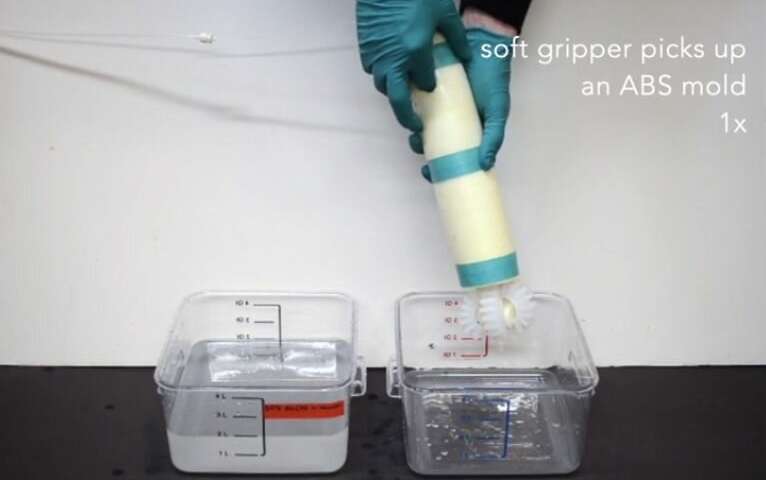
Researchers at Harvard University have designed the first rubber computer that relies exclusively on soft logic. In one of the experiments, this unusual computer was used to program a soft robot that dived and surfaced inside a transparent water tank depending on the pressure it sensed. The whole setup contains no hard or electronic parts.
In the past decade, researchers have devoted a lot of interest to soft robotics, which involves designing machines that resemble biological systems like squids, caterpillars, starfish, human hands and more. Unlike their ‘hard’ counterparts, soft robots are mostly made of elastic and flexible materials which allow them to mold to the environment. Such machines can stretch, twist, scrunch and squish, change shape or size, wrap around objects, and perform tasks impossible by rigid robotics standards. Until now, even soft robots had some rigid components they couldn’t get rid of, such as electronics — but not anymore.
“We’re emulating the thought process of an electronic computer, using only soft materials and pneumatic signals, replacing electronics with pressurized air,” says Daniel J. Preston, first author on a paper published in PNAS.
The most basic components of electronic computers are logic gates. This circuitry receives input information, runs it through some programming, and then outputs a reaction, whether printing a document or moving a robotic arm on the Y-axis. Our biological circuitry isn’t all that different. For instance, when a doctor strikes the tendon below the kneecap with a soft hammer, the nervous system reacts by jerking the leg.
To make logic gates without any electronic component, Preston and colleagues used silicone tubing and pressurized air. All complex operations performed by computers can be performed with only three logic gates: NOT, AND, and OR. By programming how the soft valves react to different air pressures, the researchers were able to replicate all three of these logic gates. For instance, the NOT gate simply works like this: if the input valve has high pressure, the output will be low pressure. In the case of the fish-like robot which the researchers experimented with in a water tank, the NOT logic gate uses an environmental pressures sensor. When the sensor registers low pressure at the top, the robot dives and then surfaces when it senses high pressure. The command can also be controlled through an external soft button, as you can see in the video below.
Soft robots have their own set of advantages that make them uniquely suited for a range of applications. Modern assembly lines are packed with hard robots that perform all sorts of extremely precise and fast operations. However, if a human happens to get in the way, serious injury becomes a huge risk. With soft robotics, this is not a problem because they can only exert so much force.
Some of the properties that make soft robots so attractive are affordability, ease of manufacture, light weight, resistance to physical damage and corrosive substances, and durability. Soft robots also have the benefit of being capable of operating where electronics struggle, such as in the presence of high level of radiation or in outer-space. These properties make soft robots particularly appealing for humanitarian and rescue operations, such as in the wake of a flood, hurricane, or nuclear power plant meltdown. “If it gets run over by a car, it just keeps going, which is something we don’t have with hard robots,” Preston says.
Soft robotics offer another interesting possibility. Because there are no electronics, a completely soft robot could be made from materials which match the refractive index of water. When completely submerged, the robot would appear transparent. Preston says he hopes to make an autonomous soft robot that is invisible to the naked eye and perhaps even to sonar.
In a sea of information overload, artificial intelligence, and all sorts of complex computing, it’s refreshing to see new concepts that actually hinge on simplicity.
“There’s a lot of capability there,” Preston says, “but it’s also good to take a step back and think about whether or not there’s a simpler way to do things that gives you the same result, especially if it’s not only simpler, it’s also cheaper.”


